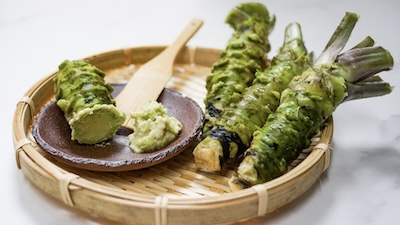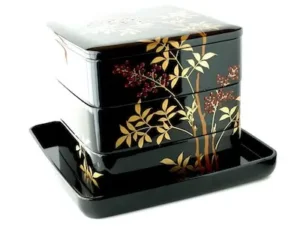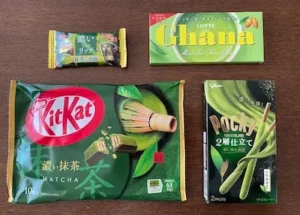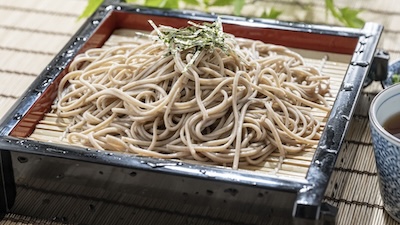
Fresh Wasabi: Flavor, Tradition, and the Perfect Pairing with Soba
Essential Fresh Wasabi: The Perfect Partner for Soba
In Japan, people often eat soba noodles with wasabi. The wasabi is not mixed in.
It’s served as a small dab on the side.
That sharp kick doesn’t just add spice. It actually brings out the flavor and aroma of the soba itself.
However, the wasabi served in many restaurants is a processed paste from a tube.
Real, freshly grated wasabi is something entirely different.
Health Benefits of Fresh Wasabi: Japan’s Native Herb
Wasabi is a herb native to Japan. It has been used for centuries.
People value it not only for its flavor but also for its health benefits.
It’s said to stimulate appetite and promote blood circulation. It also has natural antibacterial properties.
This is one reason it’s often served with raw fish. Wasabi is more than just a condiment. It is also good for your body.
The Unique Flavor of Freshly Grated Wasabi
Freshly grated wasabi has a light, clean spiciness and a refreshing aroma.
The sharpness hits quickly but fades just as fast. It leaves behind a subtle sweetness.
It enhances the flavor of the food without overwhelming it.
Because the flavor fades quickly after grating, fresh wasabi is best enjoyed immediately.
The Charm and Taste of Wasabi Stems
One lesser-known part of the plant is the wasabi stems.
These slender green stalks are crunchy and mild. They have no spiciness at all.
The stems have a pleasant bitterness and fresh aroma.
This makes them delicious in salads or pickled side dishes.
While the root is famous for its heat, the stems offer a more subtle, refreshing taste worth trying.
Enjoying the Natural Goodness of Fresh Wasabi in Azumino
ube wasabi can’t compare to freshly grated wasabi. Fresh wasabi has a vibrant aroma and complex flavor.
The wasabi stems have a crisp freshness. Once you taste them, you’ll see this plant in a new light.
For soba lovers and curious foodies, a visit to Azumino is special. You can experience real wasabi
—authentic, fresh, and full of life.
Fresh wasabi is often enjoyed with soba noodles — especially regional varieties like Shinshu soba.
→ Discover the charm of Shinshu Soba
Japanese of the Day / 今日の日本語
- Word:新鮮 (しんせん / shinsen) – fresh
- Meaning:Shinsen describes something that is fresh or newly made.
It can be used for food, air, ideas, or experiences. - Example:この魚はとても新鮮です。(Kono sakana wa totemo shinsen desu.)
(This fish is very fresh.) - Fun Fact:In Japanese, shinsen is often used to describe food like fish or vegetables, emphasizing their quality and taste.
◆ Would you like to talk about Japanese culture? ◆
In the Culture Course, you can learn to speak about Japanese culture with me.
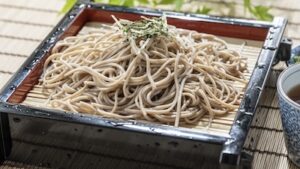

そばに欠かせない名脇役
そばを食べるとき、つゆに少し添えられる「わさび」。
ピリッとした辛みが、そばの香りや甘みを引き立ててくれます。ほんの少量でも、その存在感は絶大です。
ですが、実は多くの店で使われているのは、チューブ入りの加工わさびです。
本物の「生わさび」とは、見た目も香りも、そして味わいもまったく異なります。
体にもやさしい、日本のハーブ
わさびは日本原産のハーブの一種です。
古くから薬効が知られており、食欲増進、抗菌作用、血液の循環促進など、さまざまな効能があると言われています。
魚介類と一緒に食べることが多いのも、その抗菌効果を活かすためです。
薬味としての役割だけでなく、体にもやさしい存在なのです。
すりたてだけの特別な味
生わさびは、すりおろした瞬間から香りが立ち、爽やかな風味が広がります。
ツンと鼻に抜けるやさしい辛みは、一瞬で消えて後に残りません。
辛さの中にほんのりと甘みがあり、料理の味を引き立てながら、素材の風味を壊すことはありません。
すりたてのわさびは時間が経つと辛みが失われてしまいます。その場で味わうのが一番おいしいと言われています。
実は「茎」もおいしい
意外に知られていないのが、わさびの茎のおいしさです。緑色の細い茎は、見た目も美しく、シャキッとした食感があります。
茎には根のような辛みはなく、まったく辛くありません。
ほんのりとした苦味と爽やかな香りがあり、漬物や和え物にするととてもおいしいです。
自然の恵みを一口に
チューブでは出せない、すりたてだけの豊かな風味。そして、見た目にも香りにも癒される、わさびの茎のおいしさ。
そば好きはもちろん、わさび本来の魅力を知りたい方にとって、安曇野のわさび体験は忘れられない思い出になるでしょう。
安曇野の水と空気が育てた、生わさびの本物の味を、ぜひ一度ご賞味ください。
生わさびがよく合う、日本の伝統的なそばにも注目してみませんか?
→ 発見!「信州そば」

